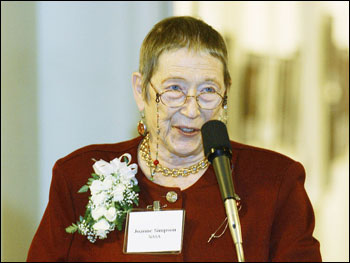

Retiring as a Role ModelFrom her early work at Woods Hole to TRMM, Simpson says she really doesn’t have any regrets. She does, however, admit that she would like to have given her three kids more mothering in their early childhoods, but she says that meteorologists are typically in their prime productivity in their 30s or 40s. In the 1950s and 1960s, day care centers did not exist, so Simpson had frequently to hire new baby sitters and sometimes bring her kids with her to work. Now Simpson says she has a wonderful relationship with her grown children and that they have all become involved in science in some capacity. “They all tell me that they are glad I continued on my career path. They seem to have pretty happy memories of their childhoods,” she says. 
In the 21st century, Simpson continues to receive accolades and break new ground. Here she gives the acceptance speech for the International Meteorological Organization Prize in 2002. She was the first woman to win the award. (Photograph courtesy NASA) Regardless of the obstacles faced by women in her time, Simpson says she was lucky to get into meteorology when she did. She was in the profession during a time when some of the biggest discoveries were made. However, being the first woman in meteorology really pushed her. Not only were her personal goals and profession on the line, but also she felt responsible for the fate of other, younger women who wanted to be meteorologists. “I have always felt that I’ve been carrying a big burden for other women, because if I mess up then the chances for other women to get the same kind of job are going to be diminished,” says Simpson. But here is one arena from which Simpson is willing to retire. “I think I can now retire as a role model, since there are so many really great younger women meteorologists—many of whom have children, too—who are serving that function extremely well.”
back: The NASA Years
|
| ||